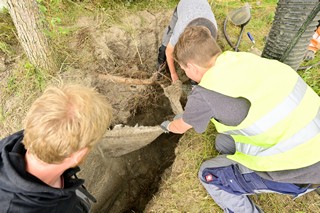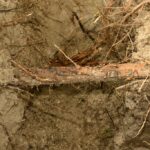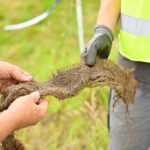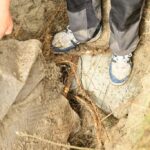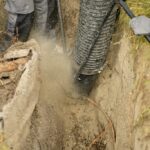After six years: IKT researchers dig up their test stand for tree roots
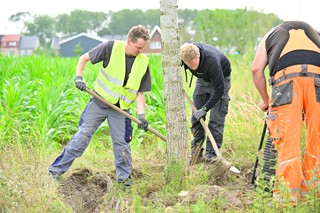
After six years of growth: IKT researchers dig up their tree root test stand in Almere (Netherlands)
At the start of the project, IKT laid wastewater pipes with various protection systems underground. They then planted trees on top.
The researchers left the roots to grow in peace for six years. They only checked on them from time to time. In August 2024, the time had come: they dug everything up to see how the roots had developed and how well the pipes were protected from them.

IKT researchers pull protective matting out of a sewer pipe trench that they installed six years ago to protect against root ingrowth.
Sewage network operators are constantly struggling with root ingrowth in sewage pipes. Obstacles to drainage can form and even cause complete blockages. These then have to be laboriously milled out. In the worst case, the only solution is expensive excavation. Structural protection measures are designed to prevent precisely this, so that trees and pipes can coexist in harmony in cramped urban spaces.
Material mix in the experimental setup
IKT researchers therefore want to find out which passive measures are suitable for protecting pipes. Six years ago, they set up a worldwide unique in-situ test stand for this purpose. At a depth of 1.20 metres, they laid two 30-metre-long DN 150 and DN 300 sewer pipes in parallel. On top they planted five fast-growing poplars, each five metres apart.
What works against root ingrowth?
In the bedding area around the trees, the IKT researchers installed eight root barriers, such as foils and vertical panels from various manufacturers, as well as two mineral encapsulations.
That was six years ago. The poplars are now ten metres tall and in great shape. Time to see how the roots have grown and whether the protective measures are working.
Digging like archaeologistsThe IKT researchers took archaeological care when excavating the roots of their trees so as not to damage the roots.
They meticulously documented how the roots had grown. Their painstaking work took a whole week with the help of hand shovels, suction excavators and compressed air lances.
Roots surprise researchers
Visually alone, there was something unexpected: even thick roots branched out like an ancient Roman trident when they encountered resistance. They followed the relatively loose soil space around the sewage pipes. They looked for their way and found it. They bypassed the built-in obstacles – successfully at first glance.
Of the 15 pipe connections, 13 withstood the roots, two did not. The connections between the vertical protective plates were also not impenetrable in all cases. The roots snaked through here too.
Back to the lab
Now it’s back to the lab, where the researchers will investigate exactly what the roots have done. The final results of this research project are expected in early 2025 – we will report back.

IKT root expert Dr Mirko Salomon and biologist Prof Dr Thomas Stützel from Ruhr University Bochum (right)
The IKT root test stand is located in a new development area in the city of Almere, near Amsterdam. It was set up in the winter of 2018/2019 and has now been dismantled.
We would like to thank the city of Almere and the Dutch foundation RIONED for funding the project to the tune of 205,000 euros. Prof Dr Thomas Stützel, Director Emeritus of the Biological Garden at Ruhr University Bochum, supported us with his impressive wealth of knowledge as a biologist and root expert.
Photo gallery: Excavation of the IKT tree root test field
in Almere/Netherlands
Click on pictures for full view
#gallery-1 { margin: auto; } #gallery-1 .gallery-item { float: left; margin-top: 10px; text-align: center; width: 25%; } #gallery-1 img { border: 2px solid #cfcfcf; } #gallery-1 .gallery-caption { margin-left: 0; } /* see gallery_shortcode() in wp-includes/media.php */
- The IKT test field with poplar trees in a new housing estate in Almere/Netherlands
- Researchers in the field: Prof Dr Thomas Stützel from Ruhr University Bochum and Kilian Möllers, M.Eng. from IKT (r.)
- Protective mat to stop roots
- Tree roots are cleared with suction excavators, shovels and by hand.
- Horizontal root ingrowth in the pipe trench
- Root mats excavated from the IKT test stand
- Protective mat, roots and sewage pipe
- Almost like an ancient Roman trident: tree roots grow towards the sewage pipe
- Looking vertically down into the pipe trench: The black protective mat against roots is clearly visible
- Suction excavator carefully removes soil around sewer pipes without damaging tree roots
- Roots and sewage pipes are excavated with great patience and sensitivity.
- Information board at the IKT test field in Almere/Netherlands
